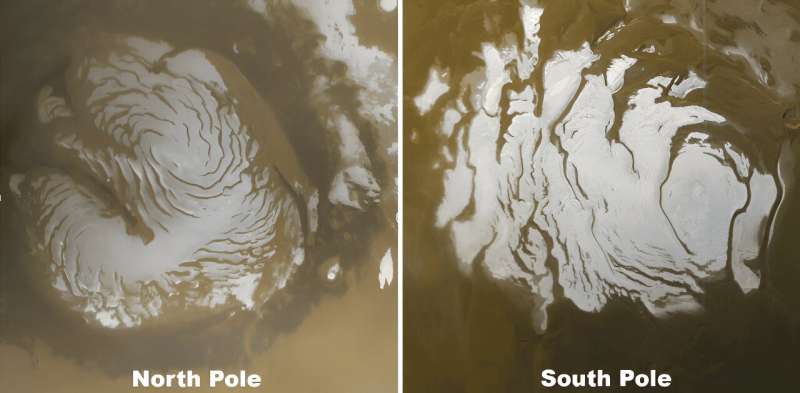This article has been reviewed according to Science X's editorial process and policies. Editors have highlighted the following attributes while ensuring the content's credibility:
fact-checked
peer-reviewed publication
trusted source
proofread
Fifty-year mystery of Mars' slow polar ice flow solved

Mars polar ice caps were one of the first Earth-like characteristics identified on Mars. Since the development of film in the 19th Century, researchers expected to see Earth-like activity, such as polar ice flow. Mars, however, doesn't follow expectations.
In 1971, Mariner 9 data saw the south polar ice on Mars for the first time—setting off a 50-year debate about whether the ice is flowing or not. Every time an interpretation of flow arose, it was quickly ruled out by new observations.
For 50 years, researchers have struggled to explain this immobile ice. Now, a new paper led by Planetary Science Institute Senior Scientist Isaac Smith has an answer: the ice, which is made of varying layers of material, may be held in place by those layers.
High-resolution images of the Mars polar ice caps reveal complex layered structures. These caps are about 2-3 km (1.2 to 1.9 miles) thick and sprawl more than 1,000 km (600 miles) across the Martian poles. These caps are made primarily of water ice. Beneath the ice lies a complex landscape that includes steep slopes and cliffs.
Researchers had expected that ice flows could reach speeds up to 1m a year in these regions, and even modest flow predictions forecast flows of 10 cm per year. This rate of motion would be visible in images taken over a short time by modern missions, with their ability to resolve features as small as 1.2–2.4 m (4–8 feet). Long duration flow should also be visible in other features such as moraines (or rubble piles), depressions in the icy cliffs, and layer warping. None of this is seen in any location on either polar cap.
Given the lack of observations supporting flowing ice, as Smith puts it, "So, the question is, why is the ice moving more slowly than predicted, and how slow is it? We have an upper limit, so let's test some hypotheses. In my paper, I looked at four hypotheses to see if they could slow down the ice."
In a paper appearing in the journal Icarus, "A hypothesis for undetectable flow at the polar layered deposits of Mars," Smith works through the complex calculations for four different scenarios: 1) the ice is too cold to move, 2) impurities in the ice slow it down, 3) it's homogeneous mixture of material slows the flow, 4) the ice is layered in ways that uniquely slow the ice to an unmeasurable flow.
While all four ideas sounded possible, the mathematical models showed that in the first three instances, the ice should still have been observably on the move and leaving behind evidence. Only in the last, layered landscape model, was the ice fixed in place.
"The layers are similar to making smores or an Oreo cookie—stiff layers with soft layers in the middle. If you stack enough oreos on top of each other and press, there will be some flow, but not nearly as much as if you had a mixture of oreo crumbles," explains Smith. "The layer model can slow things down by several orders of magnitude—enough to match the observed motions (or lack thereof)."
As we build up models that allow us to understand the diversity of glaciers in our solar system, we start to see just how physics can be the same everywhere but specific, local conditions make things act very differently. It is easy to imagine Mars as Earth-like, and maybe once it was, but for the past billion years or so, Mars has had a unique, harsh climate that leaves very un-Earth-like features for us to study.
"Researchers, as far back as Percival Lowell have been considering Mars polar caps. Lowell even considered flowing ice and canals to help people living on Mars," says Smith, in reference to Lowell's work in the late 1800s and early 1900s.
"We need to understand the basic physical principles before we can say much more about what is happening on other planets. This is pretty esoteric. Very few people get into ice sheet dynamics on other planets, but many more people care about the history of ice on Mars. Without the proper context, we can be misguided for decades.
"Getting it right, means knowing which processes are active and which are not. I think this paper gets us a lot closer to understanding why the ice on Mars behaves in the non-moving way it does."
More information: I.B. Smith, A hypothesis for undetectable flow at the polar layered deposits of Mars, Icarus (2024). DOI: 10.1016/j.icarus.2024.116125
Journal information: Icarus
Provided by Planetary Science Institute





















